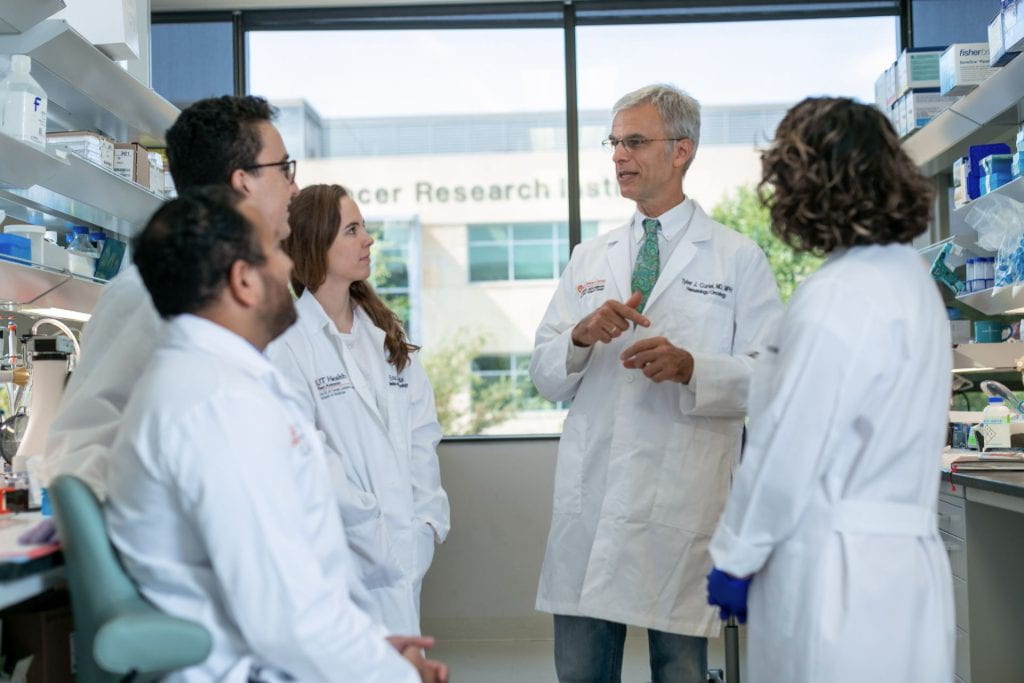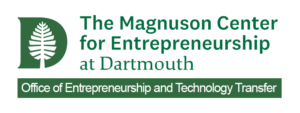Cancer Accelerator Fast-Track Awards Fund Research Toward More Effective, Less Invasive Treatment Options
Five Accelerator teams are utilizing $100,000 in funding to quickly advance projects ranging from drug repurposing that will make chemo more powerful to a hand-held device to help patients avoid biopsies.

Dr. Tyler J. Curiel is working toward a world where every cancer patient has a viable treatment available to them.
“I’d love to make the world—I’m not going to say cancer free—but cancer tolerant, where there’s nothing that we can’t treat,” the Professor of Microbiology and Immunology at Geisel School of Medicine said. “We’re working 24/7 trying to make this happen.”
Most recently, that work has been focused on repurposing approved drugs that can make cancer treatments more effective, doubling or tripling the impact of standard treatment protocols. As part of the most recent cohort of the Dartmouth Innovations Accelerator for Cancer (DIAC), Curiel and his research team are investigating antibiotics that can enhance the impact of chemotherapy and radiation when given alongside those treatments. Curiel’s research group is one of five teams that received a combined $100,000 in funding from DIAC at the end of the fall term to fast track their projects. The intent of these awards is to provide selected teams with funding to do work on their projects over the first three months of the year and then report back to the Accelerator Review Panel in early spring on the progress they have made.
“Having these resources allows teams to catalyze translational efforts and enables them to move along down that pathway a little bit quicker,” said Dr. Ryan Halter, Associate Professor of Engineering and Program Lead for Biomedical Engineering at Thayer, and Adjunct Associate Professor of Surgery at Geisel School of Medicine, whose team was awarded $10,000 in fast track funding. “That’s one of the goals of DIAC, and it’s working.”
Utilizing drug repurposing with big results
Curiel’s team has already shown that an existing antibiotic, cefepime, can selectively deplete PDL1, an immune checkpoint molecule that allows cancer cells to repair damaged DNA. Without PDL1, cancer cells have less ability to repair damage caused by chemotherapy, radiation, and other treatments, so the addition of cefepime to certain regimens makes the treatment much more effective.
Cefepime is very impactful, but it’s inconvenient, since it must be given via IV infusion multiple times a day. Because of his background as an infectious disease specialist, Curiel knew there were drugs in the same class as cefepime that can be administered via a once-a-day pill.
Using $30,000 in fast-track funding from DIAC, his team is currently testing the protocol with the more convenient pill in mice. If that’s effective, they’ll move toward clinical trials with the pill. If not, they’ll move ahead using cefepime.
No matter which antibiotic is ultimately used, the approach could be especially significant for treating brain cancer, since these types of antibiotics cross the blood-brain barrier, something many drugs can’t do.
“It’s a chance to make an intervention in cancers that are notoriously hard to treat,” Curiel said.
In addition to his current DIAC project, Curiel’s team is moving ahead with a project from a last year’s accelerator, focused on a new target for immunotherapies: PDL2. Last year, that project received $150,000 in DIAC funding. Within a few years, Curiel expects that protocol to be used in clinical trials.
“It’s been a lot of progress going very rapidly, and we’re making a lot of in-roads very quickly at this point,” he said.
A novel treatment, with fewer side effects
Dr. Esteban Orellana, Assistant Professor of Molecular and Systems Biology at Geisel School of Medicine, is researching a cancer treatment that could help destroy malignant cells without giving patients harsh side effects. His approach aims to inhibit the production of a specific tRNA, a molecule that’s found in cancer cells, but not in healthy tissue. Because of that, the targeting tRNA could result in a “cleaner” treatment for cancer, without the side effects that make treatments terrible for patients.
DIAC has been instrumental in supporting Orellana’s ultimate goal: to take the promise he’s seeing at the lab bench and move it to the patient’s bedside.
"That's something that gives me purpose,” he said. “I find my research very fulfilling because what I’m doing hopefully will one day help someone.”
Orellana came to Dartmouth last summer. When he heard about DIAC, he realized that the accelerator was a natural fit for his goals. Participating in the cohort allowed him to connect with a mentor in the pharmaceutical industry, and Tuck students with a strong grasp of business protocol. Those relationships have guided him to conduct his research with an eye toward translation, something he might not otherwise do as an academic, he said.
Orellana’s project was awarded $25,000 in fast-track funding in the fall. He’s using that money to conduct small studies in mice. The funding has allowed Orellana to move ahead with experimental research, providing critical data showing that the target is working.
“Some of the work I do is very risky, because we’re proposing a novel target,” he said. “It’s very difficult to get funding for something that’s seen as risky.”
Thanks to the DIAC funding and the data it’s helped provide, he’ll be able to pursue other sources of funding, he said.
A hybrid microscope with AI power
Dr. Aravindhan Sriharan, a pathologist at Dartmouth Hitchcock Medical Center, is developing a digital microscope that could result in faster diagnoses for patients, and a more tailored approach to treatment.
The SmartScope pairs the ergonomics of a traditional microscope with the promise of digital imaging and artificial intelligence. Pathologists like Sriharan use a dummy slide to move through a digital image, a process that is much faster than looking at digital images on a computer or a traditional microscope.
“Pathology has been reluctant to go digital because there are studies showing it’s four to five times slower on the screen,” Sriharan said.
The SmartScope not only addresses that, but also integrates artificial intelligence that eventually could be used to inform treatment options and democratize access to cancer treatments across the globe.
“This is a chance to use great new tech of the era, AI, and bring it to bear on the difficult questions of disease,” Sriharan said.
The Accelerator allowed Sriharan to find a mentor from a large company that produces digital images, something “we would not have access to outside DIAC,” he said. He’s also been able to refine the complicated and varied value propositions of the SmartScope into an effective pitch. With $20,000 in fast-track funding, Sriharan plans to refine the messaging around the microscope, attend professional conferences for doctors, and ultimately examine ways to secure more funding through the National Institutes of Health.
“DIAC has been instrumental in connecting us with the appropriate people and resources,” he said. “It’s given me a ton of experience in a short amount of time.”
Read more: DALI Lab’s SmartScope Marries Physical Design and Technology in Unique Project.
Synthetic bone grafts for faster healing
Dr. Katherine Hixon, PhD, Assistant Professor of Engineering and Clinical Assistant Professor of Orthopedics at Thayer School of Engineering, is participating in the Accelerator for the second time.
Last spring, her team was part of DIAC’s 3rd cohort. After that ended, Hixon and her researchers continued talking with the entrepreneurs and investors on DIAC’s External Review Panel. Based on those conversations, they pivoted their research project, GYROGEL, a synthetic bone graft substitute that could encourage faster bone growth in cancer patients following surgery. They’re now focused specifically on using GYROGEL for complex craniofacial applications.
“This allows us to focus on non-weight bearing scenarios, while adding a complex geometry component to really highlight the novelty of our 3D-printed/scaffold construct,” Hixon explained.
Her team will use $20,000 in fast-track funding to purchase a furnace, which students in her lab discovered will improve the biocompatibility of GYROGEL, and ultimately promote faster bone growth in patients.
“The students are truly the driving force behind this project,” Hixon said.
Read more: DIAC Participation Shapes Students’ Academic Paths and Career Aspirations
A handheld device to detect cancer cells
Dr. Ryan Halter, Associate Professor of Engineering and Program Lead for Biomedical Engineering at Thayer, and Adjunct Associate Professor of Surgery at Geisel School of Medicine, has a long history of biotech innovation.
“My lab is looking at being that glue between the basic science and the clinicians who are going to use our technology,” Halter said.
DIAC has enhanced his ability to play that role. During this cohort, Halter’s team is led by Sophie Lloyd, a third year PhD candidate developing a way to speed up cancer treatment and help patients avoid painful biopsies. Lloyd has created a hand-held device that doctors can use during surgery to measure tissue connectivity and determine whether cancerous cells remain in a patient’s body after a portion of tissue is removed.
With $10,000 in fast-track funding from DIAC, Lloyd is refining the prototype into one that is more easily manufacturable. She’s working closely with surgeons who may one day use the device, with an eye toward clinical applications that she might not have without DIAC.
“DIAC provides a lot of new knowledge-gaining opportunities to the students, but also the ability to partner with industry mentors, investors and folks at Tuck,” Halter said. “Through that, the DIAC program is providing support for commercialization efforts.”

